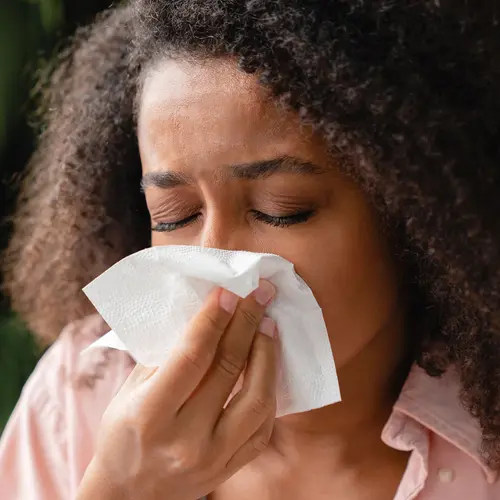For people with seasonal nasal allergies, spring and fall can mean an outside world that’s as painful as it is pretty, particularly as climate change increases both the amount of pollen in the air each year and the duration of peak allergy season.
Part of what makes pollen allergies so annoying is that there’s no quick, permanent fix. But go looking for one, and you might find many social media accounts and retailers suggesting that eating honey made by bees in your area could rid you of sensitivities to flora for good. Compared to the options of over-the-counter allergy medications, such as nasal corticosteroid sprays and antihistamines, which only provide symptomatic relief, and immunotherapy treatments that can require regular visits to the allergist, honey can seem appealing. But there’s little evidence to back it up and a few key reasons why allergists say it just doesn’t make sense.
The Idea Behind Local Honey for Allergies
Local honey as a treatment “sounds good in theory. It sounds kind of scientific-y,” says Zachary Rubin, MD, an allergist in the Chicago area and a spokesperson for the American College of Allergy, Asthma, and Immunology. It’s even pitched as a riff on the very real medical practice of allergy immunotherapy. Patients who ask him about the strategy, Rubin says, generally believe that because honey contains pollen, eating a bit every single day as a series of “tiny little exposures” will, over months, train the body to become desensitized to the allergen.
The emphasis on using locally made honey suggests scientific roots, too. Every plant species has chemically distinct pollen, and people with seasonal allergies are each allergic to the pollen of one or more particular species, rather than the substance as a whole. Because bees collect pollen from nearby plants, the notion is that local honey will contain the perfect pollen cocktail representing the exact variety of species that people in the area are exposed to – and triggered by.
But this idea isn’t able to stick the landing.
The Reality of Pollen and Local Honey
It’s true that effective immunotherapy for pollen allergies involves exposure to the specific pollens (or closely related ones) that trigger your symptoms, which are likely to be found in your area. There’s just one issue: Those pollens almost certainly aren’t in your honey.
Pollen allergies are nearly always caused by trees, grasses, and weeds, Some culprits, including birch and ragweed, are among the most common triggers in the U.S. In contrast, “bees eat nectar and gather pollen from flowers,” says Melanie Carver, chief mission officer of the Asthma and Allergy Foundation of America.
Though their dense, yellow pollens are perhaps most familiar to us, flowers just aren’t pollen hotbeds. “Even for people who work with flowers, it’s generally the fragrance that causes an issue versus the actual pollen,” Rubin says. “You really have to be exposed to a lot of it, and it has to aerosolize, and that doesn’t really happen with the heavier, stickier pollens.” These benign pollens are the backbone of honey.
Even if the pollens you’re most sensitive to make it into local honey, there’s no guarantee that their concentrations will be high enough to trigger an immune response. One batch of honey can contain pollen from more than three dozen plant varieties, though most studies of multifloral honeys find averages somewhere between 10 and 20 varieties.
And that ties into the even bigger giveaway that local honey immunotherapy doesn’t work: sloppy dosing. Part of the reason why medical immunotherapy for allergies, in which allergy shots or under-the-tongue drops or tablets are given over time, works is that doses are carefully measured to elicit small, manageable immune reactions.
“With allergy shots, your doctor injects you with increasing amounts as your body adjusts and observes you for allergy symptoms,” Carver says. If a spoonful of honey contained the right amount of pollen to work up to desensitization, “every time you eat honey, you would be itching,” Rubin says.
And even though some people who sell and promote local honey for allergies provide recommended doses over time based on body weight, these measurements can’t account for the range in actual pollen concentrations.
What the Research Shows
Local honey treatment for people with seasonal allergies hasn’t been tested in any peer-reviewed studies. But a few researchers have looked at honey, in general, as a potential shorter-term treatment for allergy symptoms and are commonly cited when people promote local honey remedies. Even so, “most studies on honey and allergic response are limited by small sample size,” Carver says. Aside from the soothing properties it has on the way down, honey just doesn’t have proven medicinal use for allergies.
Still, there’s little risk in eating local honey, except for infants. Rubin and Carver both stress the importance of heeding the American Academy of Pediatrics’ recommendation to never give any honey to children under 12 months old due to the risk of botulism.
Although local honey isn’t a reliable remedy for allergies, there are proven treatments for pollen allergies. Allergy immunotherapy has a low rate of follow-through, given that a full course of treatment can take 3 years. But it also has a high success rate. Research shows that 90% of people who receive some form of allergy immunotherapy see significant improvement, and the results can last nearly a decade. You can even be treated for a truly personalized collection of pollens.

